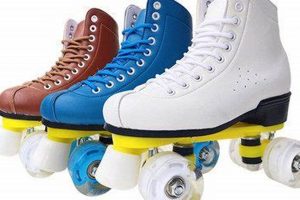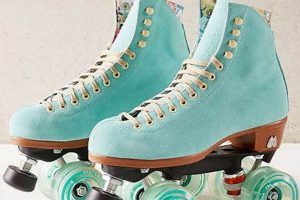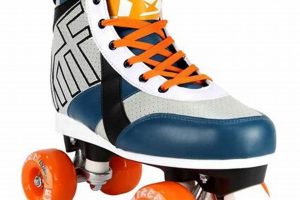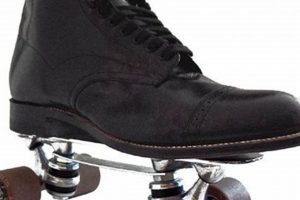The pursuit of optimal recreational or competitive wheeled footwear often leads individuals to consider high-performing models. These products represent a category of personal mobility devices designed for smooth, efficient movement across paved surfaces. An example would be a skate engineered with a lightweight frame, precision bearings, and supportive boot construction, prioritizing both speed and rider comfort.
The significance of selecting appropriate equipment resides in its capacity to enhance performance, minimize the risk of injury, and elevate the overall user experience. Historically, advancements in materials science and engineering have contributed to lighter, more durable, and responsive designs, expanding the possibilities for both casual users and dedicated athletes. This equipment can contribute to improved cardiovascular health, enhanced agility, and recreational enjoyment.
The following discussion will delve into the crucial factors that inform the selection process, examining key features, performance characteristics, and suitability for various skill levels and intended applications. This includes, but is not limited to, the discussion of frame materials, wheel durometer, bearing quality and boot support.
Guidance for Optimal Rollerblade Selection
Selecting suitable rollerblades requires careful consideration of several key attributes. These recommendations aim to aid in making an informed purchasing decision.
Tip 1: Prioritize Boot Comfort. The boot should fit snugly without causing pressure points. Ill-fitting boots can lead to blisters and diminished control. Testing boots with appropriate socks is crucial.
Tip 2: Evaluate Frame Material. Aluminum frames offer superior power transfer and durability compared to plastic frames, especially for advanced skaters. A composite frame may be a better choice for beginners who value shock absorption and comfort.
Tip 3: Consider Wheel Durometer. Wheel hardness, measured in durometer (A), affects speed and grip. Softer wheels (lower A number) provide better grip but wear faster. Harder wheels (higher A number) are faster but offer less grip. Choosing the right durometer depends on the skating surface and style.
Tip 4: Assess Bearing Quality. Bearings are rated by ABEC (Annular Bearing Engineering Committee) numbers. Higher ABEC ratings generally indicate greater precision and smoother rolling. However, high-quality bearings from reputable manufacturers are more critical than ABEC ratings alone. Ceramic bearing are also an option for performance.
Tip 5: Determine Intended Use. Different rollerblades are designed for specific purposes, such as recreational skating, speed skating, aggressive skating, or fitness skating. Selecting a model designed for the intended use will enhance performance and safety.
Tip 6: Inspect Closure System. A secure and reliable closure system is essential for maintaining foot stability. Consider buckle, lace, and Velcro combinations to achieve a customized fit.
Tip 7: Check Brake Availability and Position. Ensure a functional brake is present, especially for beginners. Evaluate its position and ease of use. The brake should be easily accessible without requiring excessive effort or compromising balance.
Adhering to these recommendations helps to ensure a rollerblade selection that maximizes performance, comfort, and safety. Careful evaluation of the aforementioned features is paramount to a satisfactory skating experience.
The subsequent sections will explore advanced considerations, including maintenance and troubleshooting, further enhancing the understanding of rollerblade ownership and operation.
1. Performance
Performance, in the context of wheeled footwear, directly correlates with speed, efficiency, and control. A high-performing product allows the user to achieve greater velocity with less effort, maintain stability during maneuvers, and execute precise movements. This capability is crucial for competitive applications such as speed skating or roller hockey, where even marginal improvements in performance can determine success or failure. Conversely, enhanced performance contributes to increased enjoyment and skill development in recreational skating, allowing users to explore more challenging terrains and execute advanced techniques.
The attainment of optimal performance hinges on several design and material considerations. Aerodynamic boot designs, lightweight frame materials, and high-quality bearings minimize energy loss and maximize speed. Stiff boot construction and responsive frames enhance power transfer, enabling efficient acceleration and precise control. Wheel durometer and profile influence grip and rolling resistance, further contributing to overall performance. For example, speed skates typically feature harder wheels with a larger diameter to minimize rolling resistance and maximize speed on smooth surfaces, while aggressive skates utilize smaller, softer wheels to enhance grip and maneuverability in skate parks.
In summary, the performance characteristics significantly determine the suitability of wheeled footwear for a given purpose. While cost considerations often influence purchasing decisions, prioritizing performance attributes ultimately translates to enhanced user experience, improved skill development, and a reduced risk of injury. The interplay between design, materials, and intended application dictates the overall effectiveness and utility of the product.
2. Comfort
Comfort is a critical factor in evaluating the suitability of wheeled footwear. Prolonged usage, inherent to the activity, necessitates designs that minimize discomfort and prevent injury. Ill-fitting or poorly constructed footwear can lead to blisters, chafing, and pressure points, detracting from the experience and potentially causing long-term musculoskeletal issues. Ergonomic design principles, breathable materials, and adequate cushioning contribute significantly to user comfort and influence the selection of superior equipment.
The design and materials utilized in the boot construction heavily influence comfort. Padded liners that conform to the foot’s contours, coupled with ventilation systems, reduce friction and moisture buildup. Adjustable closure systems allow for a customized fit, minimizing slippage and maximizing support. Furthermore, the presence of shock-absorbing materials in the heel and sole mitigates impact forces, reducing fatigue and protecting joints. For example, skaters engaging in long-distance fitness activities require models with enhanced cushioning and ventilation to maintain comfort over extended periods, while aggressive skaters prioritize impact absorption to withstand the forces generated during jumps and landings.
Ultimately, the pursuit of wheeled footwear requires prioritizing comfort alongside performance and durability. Disregarding this aspect can lead to decreased enjoyment, reduced performance, and an increased risk of injury. A comprehensive understanding of the design features contributing to comfort, such as ergonomic liners, breathable materials, and shock absorption, enables informed purchasing decisions. Selecting products that prioritize both functionality and user well-being ensures a positive and sustainable skating experience.
3. Durability
The longevity of recreational wheeled footwear is a critical determinant of overall value and user satisfaction. The material composition and construction methods directly influence the product’s resistance to wear, tear, and environmental degradation. Choosing such wheeled footwear without considering its ability to withstand regular use across diverse terrains can lead to premature failure, necessitating frequent replacements and negating potential cost savings associated with lower-priced alternatives. The importance of durability becomes particularly evident in demanding applications, such as aggressive skating or frequent outdoor recreational use.
Frame materials, for example, exhibit a significant impact on durability. Aluminum frames, while often more expensive, offer superior resistance to bending and fracture compared to plastic or composite frames. Similarly, wheel materials with higher abrasion resistance extend the lifespan of the wheels, reducing the frequency of replacements. Bearing quality also contributes to overall durability, as sealed bearings are less susceptible to contamination and corrosion, maintaining smooth rolling performance over time. Consider, for example, the difference between a budget-friendly model with plastic components and a high-end model featuring aluminum alloy and reinforced stitching. The former is prone to cracking, bearing failure, and fabric tears within a relatively short period, whereas the latter can withstand years of intensive use with minimal maintenance. Another aspect to consider is the type of closure system. Buckles, laces, and velcro straps all have different expected use-life.
In conclusion, durability constitutes a key component of high-quality wheeled footwear. While initial cost may be a deciding factor for some purchasers, the long-term benefits of enhanced durability outweigh the potential savings associated with less robust options. Evaluating material composition, construction methods, and intended use scenarios is essential for making an informed purchasing decision and ensuring a satisfactory skating experience over an extended period. Furthermore, proper maintenance, such as regular cleaning and lubrication, can significantly extend the lifespan of the product, maximizing its value and minimizing environmental impact.
4. Fit
The relationship between proper fit and high-performing wheeled footwear is inextricable; inadequate fit negates the benefits of advanced design and materials. Optimal fit ensures efficient power transfer from the skater’s foot to the blade, enhancing control and reducing fatigue. A too-loose fit allows for slippage within the boot, diminishing responsiveness and increasing the risk of ankle instability. Conversely, an overly tight fit can restrict circulation, causing discomfort and potentially leading to blisters or nerve compression. The practical consequence of improper fit manifests as reduced skating efficiency, compromised safety, and a diminished overall experience. For instance, a speed skater reliant on precise movements cannot achieve optimal performance with a boot that allows for lateral foot movement. Similarly, a recreational skater experiencing persistent discomfort will likely abandon the activity.
Specific features contribute to achieving an appropriate fit. Adjustable closure systems, including buckles, laces, and power straps, enable users to customize the boot’s tightness according to their foot shape and skating style. Heat-moldable liners conform to the unique contours of the foot, eliminating pressure points and maximizing comfort. Furthermore, attention to toe box dimensions prevents cramping and ensures adequate room for natural foot movement. The effects of these fit considerations directly impact user experience. Skaters experiencing pain or discomfort are less likely to engage in the activity regularly, while those with a secure and comfortable fit can skate for longer durations and at higher intensities. The importance of appropriate fit also extends to safety; a well-fitted boot provides superior ankle support, reducing the risk of sprains and other injuries.
In summary, proper fit is not merely a comfort consideration but a fundamental requirement for maximizing performance, safety, and enjoyment associated with recreational wheeled footwear. A thorough assessment of foot dimensions, coupled with careful attention to boot design features and closure systems, is essential for selecting models that offer optimal fit. Neglecting this aspect undermines the potential benefits of advanced features and reduces the overall value of the product. Therefore, fit should be a primary focus during the selection process, influencing purchasing decisions and ensuring a positive skating experience.
5. Safety
Safety is paramount when evaluating wheeled footwear. The inherent risks associated with rolling at speed necessitate equipment that prioritizes user protection and minimizes the potential for injury. The design, construction, and features directly impact the likelihood of accidents and the severity of any resulting harm. Therefore, a comprehensive assessment of safety features is essential in selecting high-performing wheeled footwear.
- Ankle Support
Adequate ankle support is crucial for preventing sprains and instability. A rigid boot cuff that extends high above the ankle provides lateral stability and limits excessive pronation or supination. Insufficient ankle support increases the risk of injury, especially during maneuvers or unexpected impacts. High-performing models typically feature reinforced cuffs and secure closure systems to ensure a snug and supportive fit around the ankle joint.
- Braking System
A reliable braking system is fundamental for controlled deceleration and collision avoidance. Most models incorporate a heel brake, which requires the user to lift the toes and apply pressure to the rear wheel. The effectiveness of the braking system depends on the quality of the brake pad, the responsiveness of the mechanism, and the user’s ability to engage it quickly and effectively. Superior products often feature adjustable brake positions or alternative braking mechanisms, such as toe stops, to accommodate different skating styles and skill levels.
- Impact Protection
The incorporation of impact-absorbing materials and strategically placed padding mitigates the severity of falls and collisions. High-density foam or gel padding in the boot liner, particularly around the ankle and heel, cushions the foot and reduces the risk of bruising or fractures. Furthermore, some models include external protective elements, such as reinforced toe caps or side guards, to protect against abrasion and impact during aggressive skating or urban environments.
- Visibility Features
Enhanced visibility is an essential safety consideration. Reflective materials on the boot and wheels increase the user’s visibility in low-light conditions, reducing the risk of collisions with vehicles or other pedestrians. Bright colors also improve visibility during daylight hours. Some high-end models include integrated LED lights, providing additional visibility and signaling intentions to other road users.
These facets collectively highlight the critical role of safety features in wheeled footwear. Prioritizing these attributes ensures a safer and more enjoyable skating experience. The effectiveness of these features depends not only on the quality of the equipment but also on the user’s awareness, skill level, and adherence to safety guidelines. Helmets and protective gear, such as wrist guards, elbow pads, and knee pads, are essential complements to high-performing models, further mitigating the risk of injury.
6. Maneuverability
Maneuverability, a critical performance attribute of recreational wheeled footwear, dictates the ease and precision with which a skater can navigate various terrains and execute desired movements. Its significance is amplified in dynamic skating environments, where rapid directional changes, tight turns, and obstacle avoidance are paramount. Superior models offer enhanced maneuverability, enabling skaters to maintain control and responsiveness across a spectrum of conditions.
- Frame Length and Wheelbase
The frame length and wheelbase exert a substantial influence on maneuverability. Shorter frames, characterized by a smaller wheelbase, facilitate tighter turns and quicker responses, making them suitable for agility-focused skating styles. Conversely, longer frames offer greater stability and tracking at higher speeds but sacrifice some agility. The optimal frame length depends on the skater’s skill level, skating style, and intended application. For instance, aggressive skaters typically favor shorter frames to enhance their ability to perform tricks, while speed skaters opt for longer frames to maximize stability at high velocities.
- Wheel Configuration
The arrangement and size of the wheels significantly affect maneuverability. Rockered wheel configurations, where the middle wheels protrude slightly further than the end wheels, allow for easier turning and increased agility. Flat wheel configurations provide greater stability and power transfer but may hinder maneuverability. The choice of wheel configuration depends on the skater’s preference and the intended skating environment. Skaters navigating crowded urban areas often benefit from rockered configurations, while those primarily skating on smooth surfaces may prefer flat configurations.
- Boot Stiffness and Responsiveness
The stiffness and responsiveness of the boot contribute to maneuverability by directly influencing the transfer of energy from the skater’s foot to the frame. A stiff boot provides greater control and responsiveness, enabling precise movements and efficient power transfer. A more flexible boot may offer greater comfort but can compromise maneuverability, particularly at higher speeds. The ideal boot stiffness represents a balance between comfort and performance, depending on the skater’s skill level and skating style.
- Bearing Quality and Wheel Durometer
The quality of bearings and the durometer (hardness) of the wheels are subtle but vital factors. Higher ABEC-rated or ceramic bearings facilitate smoother, faster wheel rotation, allowing for more effortless gliding and turning. A wheel with a lower durometer (softer) provides greater grip and control, especially on uneven surfaces, but may reduce speed. A higher durometer (harder) wheel offers more speed but sacrifices some grip. The balance between bearing quality and wheel durometer depends on the skating surface and the desired skating experience.
These elements, working in concert, define the degree to which models respond to directional inputs, allowing for nuanced control and responsive handling. Achieving optimal maneuverability requires a harmonious integration of frame design, wheel configuration, boot construction, and component selection, tailored to the skater’s specific needs and preferences. An understanding of these factors enables informed purchasing decisions and a more rewarding skating experience.
7. Wheel Material
The selection of wheel material is a critical determinant of the overall performance and suitability of inline roller skates. The materials primarily employed in wheel construction directly influence grip, speed, durability, and vibration absorption. Consequently, the choice of wheel material becomes a key factor in distinguishing effective inline roller skates from less desirable options. Polyurethane (PU) is the prevalent material due to its favorable combination of properties; however, variations in PU formulations and manufacturing processes yield significant differences in performance characteristics. For example, a wheel intended for recreational use may utilize a softer PU compound to enhance grip and comfort, while a speed skating wheel would employ a harder compound to minimize rolling resistance and maximize speed.
Variations in PU formulations also dictate wheel durability. Wheels subjected to abrasive surfaces require a compound resistant to wear and tear. Aggressive skating, which involves performing tricks and grinding on surfaces, necessitates wheels formulated with high abrasion resistance to withstand constant friction. Similarly, fitness skating on outdoor surfaces demands wheels with a higher durometer rating, signifying greater hardness and resistance to wear. Furthermore, the core material of the wheel impacts its overall performance. A rigid core improves energy transfer, while a flexible core enhances shock absorption. One particular real-world application example shows the importance of using proper materials for different purposes; speed skaters utilizing soft wheels would find them wearing out extremely fast which is not ideal for training and competitions. On the other hand, aggressive skaters using hard wheels would lack the grip needed for complex maneuvers in skateparks.
In conclusion, wheel material is not merely a component but a crucial determinant of the functionality and effectiveness of inline roller skates. The material’s characteristics directly impact performance attributes such as speed, grip, durability, and comfort. Understanding the relationship between wheel material and intended application is essential for making informed purchasing decisions and maximizing the user experience. The challenge lies in identifying the specific PU formulation and construction techniques that best align with individual skating style, terrain, and performance goals. As materials science progresses, future advancements in wheel material technology may further refine the performance characteristics of inline roller skates, enabling even greater levels of speed, control, and durability.
Frequently Asked Questions
The following section addresses common inquiries and clarifies important considerations when choosing the best inline roller skates for specific needs and applications.
Question 1: What factors determine the “best” inline roller skates?
The optimal selection is subjective and depends on individual needs and priorities. Key factors include intended use (recreational, fitness, aggressive, speed), skill level, foot shape and size, desired performance characteristics (speed, maneuverability, comfort), durability, and budget. A comprehensive evaluation of these elements is crucial for informed decision-making.
Question 2: How does wheel durometer affect performance?
Wheel durometer, measured on the A scale, indicates hardness. Softer wheels (lower durometer) offer increased grip and shock absorption, making them suitable for rough surfaces and beginners. Harder wheels (higher durometer) provide greater speed and rolling efficiency, ideal for smooth surfaces and experienced skaters. The appropriate durometer depends on the skating environment and desired performance characteristics.
Question 3: What is the significance of ABEC ratings in bearings?
ABEC (Annular Bearing Engineering Committee) ratings indicate the manufacturing tolerances of bearings. Higher ABEC ratings (e.g., ABEC 7, ABEC 9) suggest greater precision and smoother rolling. However, bearing quality is not solely determined by ABEC ratings. Material quality, seal design, and lubrication also contribute significantly to performance and longevity. High-quality bearings from reputable manufacturers are often preferable to high ABEC-rated bearings from unknown sources.
Question 4: How important is ankle support?
Ankle support is crucial for stability and injury prevention. Adequate ankle support minimizes the risk of sprains and allows for more efficient power transfer. Stiffer boot cuffs provide greater ankle support, which is particularly important for beginners or those engaging in aggressive skating. More flexible boots may offer greater comfort but compromise ankle stability.
Question 5: What are the different types of frames available?
Common frame materials include aluminum, composite, and plastic. Aluminum frames offer superior stiffness and power transfer, making them suitable for advanced skaters and performance applications. Composite frames provide a balance of stiffness and shock absorption, while plastic frames are generally more affordable but less durable and responsive. The choice of frame material depends on budget, skill level, and intended use.
Question 6: How often should inline roller skates be maintained?
Regular maintenance is essential for optimal performance and longevity. Wheels should be rotated periodically to ensure even wear. Bearings should be cleaned and lubricated as needed, depending on usage frequency and environmental conditions. Frames should be inspected for damage or loose hardware. Proper maintenance extends the life of the equipment and ensures a safe and enjoyable skating experience.
These FAQs serve as a general guide. Consulting with experienced skaters or knowledgeable retailers can provide further insights and recommendations tailored to individual needs.
The following section will delve into advanced topics related to equipment customization and performance optimization.
Concluding Remarks on Superior Wheeled Footwear
This exploration has illuminated the multifaceted considerations inherent in selecting optimal wheeled footwear. From the critical importance of proper fit and robust construction to the nuanced effects of wheel material and frame design, the discussed factors collectively determine performance, safety, and user satisfaction. Each element contributes uniquely to the overall efficacy and suitability of the equipment.
The informed consumer will recognize that the pursuit of such equipment necessitates careful evaluation and a clear understanding of individual needs and intended applications. The ultimate value resides in aligning these considerations to ensure a safe, enjoyable, and enduring skating experience. Future advancements in materials and design will undoubtedly continue to refine these criteria, further enhancing the potential of this form of recreation and transportation.







